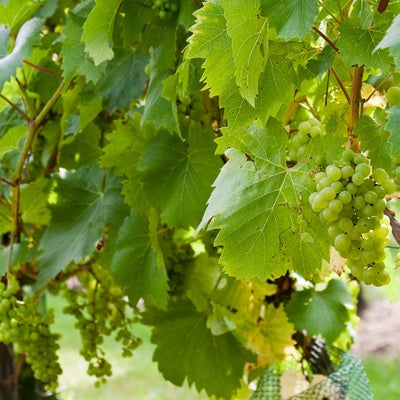
Quick facts
Common name - Grape vine
Botanical name - Vitis vinifera and Vitis labrusca
Flowering time - Summer
Fruiting time - Early autumn onwards
Planting time - October to March
Height and spread - Variable, depending on the system used
Aspect - Sun (south or south-west facing)
Hardiness - Hardy
Difficulty - Moderate
Cultivation notes
Vines can be grown outdoors in southern Britain, south of a line between Pembroke and the Wash, but with predicted temperature increases due to climate change, or in areas influenced by the Gulf Stream or with the protection of a warm wall, it is worth experimenting with cultivation north of this line. Use later-flowering cultivars in northern areas.
Site and soil preparation
Grapes need a sheltered site in full sun, ideally against a south- or south-west facing wall, or on a south- or south-west facing slope with the rows running north to south.
Avoid frost pockets unless temporary protection can be provided using horticultural .
Vines tolerate a range of soil types, providing they are free draining. Sandy gravel over chalk is ideal. Improve drainage on heavy soils by adding well-rotted organic matter and grit. Install drainage systems if necessary. A pH of 6.5-6.8 is required, so lime acid soils to raise their .
Double dig soil before planting if necessary. Incorporate a light dressing of well-rotted manure or , plus general purpose fertiliser at 100g per sq. metre (3oz per sq. yard).
Planting
Plant vines in the season from late autumn until early spring, to the same depth that they were in the pot, providing the ground is not or frozen. In areas with cold winters, March planting is preferable. The vine stems should be greater than pencil thickness, so they are not damaged by frost. Tease out the roots and spread them evenly around the planting hole before backfilling with soil.
After planting, it is a good idea to mulch with well-rotted organic matter or chipped to protect the lower from frost. Remove the from around the stem in spring, to stop the stem from rotting.
Space vines according to the method of training you wish to adopt. For more on this, see our pages on pruning and training grapes.
Feeding
In February, apply Growmore or other general fertiliser at 70g per sq. metre (2oz per sq. yard), plus sulphate of potash at 15g per sq m (½oz per sq yd) to 30cm (1ft) either side of the base of the vine.
Feed dessert grapes every two weeks with a high potassium fertiliser such as tomato feed, from a month after growth starts in the spring until the grapes start to ripen.
Watering
Although vines are fairly drought tolerant, they can suffer from the fungal disease if too dry at the roots, so water thoroughly in dry spring and summer weather.
Container cultivation
Grape vines can be grown in containers of general purpose potting media; loam-based John Innes No3 potting compost is ideal. Use a pot about 30-38cm (12-15in) in diameter and depth.
Pruning and training
There a several ways to train grapes;
- Outdoor grapes can be pruned and trained according to the Guyot system, often used in vineyards
- Vines growing against walls are trained and pruned according to the rod and spur system
- Vines in pots or where space is limited can be pruned and trained as standards
See our page on grape pruning and training for further detail.
Propagation
Vines can be propagated from hardwood cuttings in late autumn or winter. Softwood and semi-ripe cuttings can also be taken from late spring to mid-summer. Those offered commercially are often grafted.
Named grape cultivars will not come true to type from seed, so seed propagation is best avoided.
Cultivar Selection
‘Phoenix’: A mid-season white grape for dessert or wine use; good resistance.
‘Pinot Noir’: A mid to late-season black wine grape; best against a warm wall; needs good summers to crop well.
‘Siegerrebe’: An early season white grape for dessert or wine use; excellent Muscat flavour; needs protection from wasps.
Book references
Grapes: indoors and out by Harry Baker and Ray Waite (Cassel Illustrated / The Royal Horticultural Society, 2003, ISBN 1844030644)
This book is available through the RHS Lindley Library.
Links
Problems
Grape vines can suffer from powdery mildew in hot, dry weather or when growing in crowded positions with poor air circulation.
They can also suffer from grey mould (Botrytis), downy mildew and the physiological disorder known as shanking. Birds and wasps can be problematic, and it is a good idea to control wasp traps, especially with early-season grapes.
Brown scale and woolly vine or currant scale may be a problem. And the fruit fly - spotted wing drosophila (SWD) - is likely to become an increasing problem.
Vines may suffer from nutrient deficiencies, particularly magnesium deficiency.






